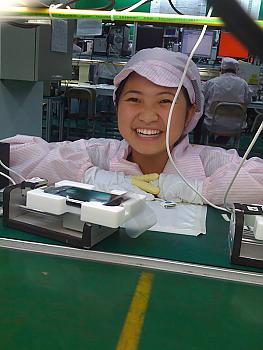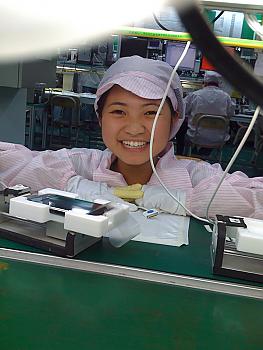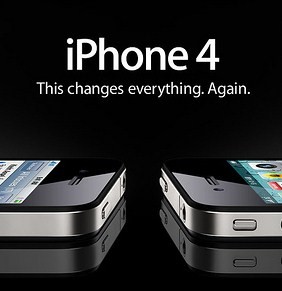Economies of Digital Production in East Asia: iPhone Girls and the Transnational Circuits of Cool
by Lisa Nakamura
[ PDF version ]
To call the Apple iPhone a fetish is only to state the obvious. It is, specifically, a commodity fetish. However, it is a special kind of digital fetish: a commodity that enjoys some of the special and exalted social status of a non-commodity. For the iPhone has, from its inception, been set apart from other cellphones; it is both marketed and understood as a tool for “making” as well as a communicative device.[i] The celebration of individual cultural production through the use of digital media devices like the iPhone is reflected in the popularity of magazines and blogs such as Make: Technology on Your Time (the “first magazine devoted to DIY technology projects”) and ReadyMade, which instruct users how to produce food, clothing, devices, and media as both signs of the ingenuity and entrepreneurialism necessary for survival in a neoliberal world and as a form of resistance to mass culture. To call oneself a “maker” is to claim an exalted cultural status, and the term “creative” has achieved the status of a noun to describe workers such as designers and artists who are “makers.” The iPhone is part of this fetish of self-sufficiency and creativity, and thus exempt from critiques of conspicuous consumption that have arisen as a logical response to a worldwide recession. Sure, the iPhone is pricey, but it is “worth it” because it is emphatically not a toy for the idle rich, but rather a tool for industrious “makers” who use it to broadcast updates, photos, and other data.
Amidst all this empowered making, we must ask: who makes the tools for the makers? Whose labor underwrites this labor? The iPhone is a fetish with a cultural and industrial origin, tied to the twin locales of Silicon Valley, the site of its design, and China, the site of its production. And in recent years it has not only imprinted its name and image ubiquitously in public and virtual space, it been appropriated by two Asian women, both dubbed “iPhone girls.” Though both have been branded as Apple products and both have gained fame as cultural “makers,” they have done so in extremely different ways.
The first iPhone girl appeared on a British Apple iPhone buyer’s brand new phone in 2008. markm49uk, proud owner of an “iMac 24”, Macbook Pro, Macbook, Power Mac G5, iPod Touch and Apple TV !,” according to his profile, posted the story in MacRumors on August 8, 2008, along with the photos themselves, which depict a cute Asian girl smiling and posing in a factory setting. He wrote, “Not sure if this is or is not the ‘norm’ but I just received my brand new iPhone here in the UK and once it had been activated on iTunes I found that the home screen (the screen you can personalise with a photo) already had a photo set against it !!!!”
"iPhone Girl." Source: MacRumors Forums
Mark’s post generated significant buzz, and this unknown young female factory worker flashing the “victory” sign (#35 of the “Things Asian People Like”) was soon dubbed the “iPhone girl.” The story went viral and was picked up by the Washington Post online, which identified the factory as belonging to Foxconn, the biggest electronics manufacturer in the world. Foxconn’s factories manufacture digital consumer electronics for Apple, Dell, HP, and other companies, and have been the site of several protest suicides and demonstrations over poor working conditions.
The iPhone girl went viral with Apple fans because she was cute and the event was unexpected. However, the iPhone girl also underwrote the illusion that Apple is “cruelty free,” and that users are not contributing to human misery by consuming it. The charm of the company’s image lies in the implication that Apple/Foxconn’s products emerge not from a sweatshop but rather from a happy, creative workplace where laborers have the time and leisure to pose for the camera to visually document their happiness—just as its consumers and “makers” do. The utopian notion that digital tools endow everyone with the same social and cultural entitlements is part of the mythology of the neoliberal commodity. For viewing tool-commodity acquisition as the solution to the problem of social inequality rather than viewing exploitative commodity production as its cause eases the conscience and extends the ideology of technological determinism. While the Chinese iPhone girl is celebrated for her ingenuity, Foxconn has since entered the news in a much less positive way, as the poster child for the ills of the “new China,” where a burgeoning middle class coexists with a hyperexploited digital working or factory class. Since January 2010, eight men and four women have either committed suicide or attempted suicide by leaping out of their factory dormitory windows in Foxconn’s two biggest Shenzhen plants. The negative publicity that resulted from this was appreciable, and the iPhone girl story has faded into the background since the story broke. As Frederick Balfour and Tim Culpan wrote in Businessweek in September 2010, “The suicides introduced Foxconn to much of the world in the worst terms imaginable—as an industrial monster that treats its workers like machines, leveraging masses of cheap labor, mainly 18-to-25-year-olds from rural areas, to make products like the iPhone at seemingly impossible prices. For Western consumers, the lost lives were an invitation to consider the real cost of their electronic playthings.[ii]
The second iPhone girl is also Asian, but she is not a worker who has, however temporarily, turned into a cultural producer; instead, she is a consumer who has turned the iPhone into a suite of musical instruments to accompany her cover performances of popular American songs. South Korean Kim Yeo Hee, also known as the “AppleGirl002,” performs Beyonce’s “Irreplaceable” and Lady Gaga’s “Poker Face” accompanied by three iPhones arranged on a rack, “making the leap from viral video sensation to recording star,” according to the Wall Street Journal. (Kim was rewarded with a recording contract with Korean studio Dreamhigh-Ent.) In classic demo-video fashion, familiar to us all from similar clips from YouTube, she explains which apps she is using (Beatmaker and Play and Share) before launching into her performances, in case viewers want to try this at home. Her work is an ingenious repurposing of an appliance touted for its multifunctionality. Like Mark, the recipient and broadcaster of the Chinese iPhone girl’s image, she is a proud Apple hyperconsumer.
Apple hyperconsumption emanates from Asia as the locale of both its labor force and its market. In September 2010, iPhone sales in South Korea topped a million. As is the case globally, demand for the iPhone far exceeded supply. As Jeff Gamet writes, “Apple’s iPhone 4 hit store shelves in South Korea on September 10 with over 300,000 pre-orders in the queue, but only 10,000 units on hand. Shoppers waited in the rain in hopes of getting their hands on the newest iPhone model. Nearly a quarter of the smartphone owners in South Korea are expected to be iPhone users by the end of 2010.” This is even more the case in China, where for the last two years the only source of supply has been smuggling from the US. In a 2008 article, “After China Ships Out iPhones, Smugglers Make it a Return Trip,” New York Times reporter David Barboza wrote that because negotiations between Apple and China Mobile had broken down, the iPhone could not be officially released in China, thereby fueling a “frenzy of global smuggling and world of mouth marketing.” China Mobile is the world’s biggest mobile service operator with more than 350 million subscribers, and when smuggled iPhones are illegally “unlocked” they can be used on its network. Two years later the situation has changed somewhat as the iPhone 4 has gone on sale in China, but in the intervening time, Nick Bilton reported in “Buyers Send iPhones on a Long Relay to China” that Chinese men and women were still “waiting silently and nervously outside of Apple stores in New York … participants in a complex and curious trade driven by China’s demand for fashionable gadgets—products that are made in China in the first place and exported, only to make the trip back.”
The Chinese iPhone girl is employed to make something that she can’t use, except clandestinely. The Korean iPhone girl deftly uses her three iPhones as production instruments and goes viral as a result. The nimble fingers of Asian women are deployed here as makers of technology and makers with technology. The agency and innovation displayed by the one is underwritten by the labor of the other. These two cases are exemplary of the differences between China and South Korea and their differing positions within the digital industrial complex. Korean products such as Samsung and Hyundai are coveted commodities outside of the country’s national borders, and “making” can take the form of Apple-enabled participatory media since many of its citizens can afford to purchase these devices. Though digital factory labor occurs in both Korea and China, it is far more likely that the digital making that occurs in China takes place on the assembly line.
The notion that one group of workers would have labor “sweated” out of them to create intricate, painstakingly crafted decorative objects to adorn the bodies of a privileged class is far from new. Victorian seamstresses labored over the tiny stitches and intricate construction of ornate dresses and other garments destined for the bodies of upper class women, and their working conditions were described in strikingly similar rhetoric to that of the Foxconn workers laboring over iPhones in China.
As several scholars have described, Victorian seamstresses became a symbol of the victimization of women by capital, and particularly of the dangers of travel from the country to the city. In “Slaves of the Needle: The Seamstress in the 1840’s,” Beth Harris writes that seamstresses were terribly exploited workers, and that their plight was publicized in popular Victorian media texts such as poet Thomas Hood’s “The Song of the Shirt” (1843) and paintings by artists such as Pre-Raphaelite painter Anna Blunden, who painted “The Seamstress (A Song of the Shirt)” in 1854. Harris writes,
In the spring of 1843, the Second Report of the Children’s Employment Commission shocked the public with horror stories of the cruel and heartless exploitation of needlewomen in the backrooms and garrets of London. The public was appalled to learn that so many “delicate” young women lived, worked, and died, in such miserable conditions, and what was worse for Victorian sensibilities, that some resorted to or succumbed to prostitution. Soon after the publication of the Second Report, the distressed seamstress became something of a cause celebre. The public was barraged with newspaper articles, pamphlets, novels, short stories, poetry (the most famous of which is Thomas Hood’s “Song of the Shirt”), and plays, many of which utilized the information on needlewomen “uncovered” by the government’s commissioners (often quoting it verbatim and at length).
What’s the difference between the iPhone girls and Victorian dress makers and shoppers? Victorian seamstresses labored over a product that was produced locally and used locally. Fancy dresses went down in price and became more accessible to the middle class due to the low production cost enabled by large numbers of country girls who needed work: girls from the country typically migrated to London to be closer to the centers of design and consumption or retail. Likewise, Foxconn and other sites of digital production in China are overwhelmingly staffed by migrant women from the countryside. However, the circuit of cultural production and consumption for the iPhone is very different from that of a Victorian fancy dress, for an iPhone cannot be consumed and produced locally; it must “round the horn” in order to return to China.
An iPhone is made in China, but due to licensing constraints, is difficult to buy in China, and like the dress it is a key class signifier, as it is in the US, increasingly identified with “cool” and with an aspirational middle class. As one of Bilton’s interviewees, a “26-year-old woman in Shanghai who works for a media company” and who waited several weeks to get the iPhone 4 told him, “Apple is a sign of coolness.” Apple has performed this hat trick consistently throughout its existence: it effortlessly broadcasts the cachet of Silicon Valley design while camouflaging its industrial origins. It is made in China, but signifies to Chinese themselves, including those who are making it, that it is not Chinese, but rather culturally Other, and “cool.” Apple has always highlighted its design origins in Cupertino (every Apple product comes with a piece of paper that states “designed in Cupertino, California”) rather than its actual production culture in China in order to preserve the image of an artisanal product, a strategy which makes it especially and enduringly globally desirable.
iPhone 4 advertisement. Source: BNET
Garment manufacture and electronics production are both tedious and difficult occupations, overwhelmingly tasked to women. These are both industries that are brutally subject to rapid change in fabrication processes and the need to meet strict deadlines, conditions that combine to produce stressful working conditions. In the garment industry this is called “fashion,” and in the technology industry it is called “planned obsolescense,” but these processes are much closer to each other than they seem, two sides of the same coin. The iPhone, “designed in California” as each product proudly declares, is an expression of the digital fashion industry as much as it is a device for makers and creatives, as much as they might like to disavow this. And the manufactured desire for the next version of the iPhone has material effects not only upon our wallets and upon the environment, but upon the lives of “iPhone girls” in Asia, girls who are now part of the first labor movement that China has seen in some time.
One difference between dressmaking and electronics manufacture, however, is that while both induce eyestrain and carpal tunnel in the producers of these objects, only the iPhone transfers the affliction onto the user. iPhones, unlike dresses, are modes of production as well as products. This is why they are the subject of less political agitation even than sweated garment manufacture in much earlier times. It is hard to defend the use value of fancy dresses, and the Victorian public had no trouble viewing them as luxury items. However, the Apple iPhone is still viewed as a privileged tool of cultural production as well as status, a productivity device rather than a frivolous decoration. The ability of the amateur to participate in media production is attributed to easy-to-use tools like the Flip Camera, the Apple iPhone, and other pretty devices made by Asian iPhone girls. Indeed, the Chinese iPhone girl demonstrates this by documenting her own desire to use the device as it was meant to be used—to “share” ourselves with the world. The crucial difference between the Korean iPhone girl and the Chinese iPhone girl has to do with their differing access to digital agency as makers. There is no lucrative media industry contract in store for the Chinese iPhone girl—many of the commentors in the MacRumors forum in which the story was originally posted expressed concern for her safety as a result of her overt violation of factory rules. Her intervention would most likely have been interpreted as industrial sabotage or at best poor quality control had the story not found favor with American readers. She still does not have a name that anyone has been able to discover. In contrast, Kim Yeo Hee is a celebrity in Korea, albeit a minor one. The contrast between these two young Asian women highlights the differences between the Asian Global South and the Global North and the ways in which the digital media revolution employs iPhone girls as producers, consumers, demonstrators, and innovators, engendering a circuit of transnational digital creation and creativity where some work in the factory so others might “make.”
Notes
[i] See Jonathan Zittrain’s book The Future of the Internet and How to Stop It for a critique of the Apple iPhone as a “closed device” that is less flexible and less productive or “generative” than a traditional personal computer. Zittrain notes that the locking-down of Apple software by centrally controlled and monitored hubs like the App Store restricts the productive potential of the device, optimizing media consumption and revenue collection while precluding many forms of digital production.
[ii] Jack Qiu’s excellent book Working Class Network Society: Communication Technology and the Information Have-Less in China (Cambridge, MA: MIT Press, 2009) explains Chinese electronics manufacturing practices and cultures in great detail.
Lisa Nakamura is the Director of the Asian American Studies Program and Professor of Media and Cinema Studies at the University of Illinois at Urbana-Champaign. She is the author of Digitizing Race: Visual Cultures of the Internet (University of Minnesota Press, 2008) and Cybertypes: Race, Ethnicity and Identity on the Internet (Routledge, 2002) and co-editor of Race in Cyberspace (Routledge, 2000) and Race After the Internet (Routledge, forthcoming 2011).




 Post a Comment
Post a Comment